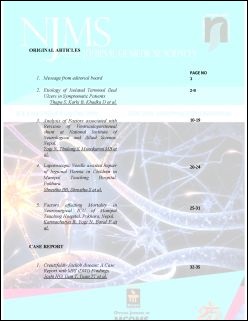Spectrum of cytological patterns in cervical PAP smears in a tertiary care center of Western region of Nepal
DOI:
https://doi.org/10.3126/njms.v4i1.24118Keywords:
cancer, cervical, Pap, screeningAbstract
Introduction: Cervical cancer is a common health problem in Nepal. There is paucity of data regarding the spectrum of findings in cervical Pap in western Nepal. This study was aimed to study the cytological patterns in cervical Pap smears in patients in a tertiary hospital of Nepal.
Methods: This is a prospective, cross sectional, hospital based study. Clinical features of patients who had presented with Pap smear was noted in a structured proforma. Pap smears were studied by a senior pathologist and reported based on revised Bethesda system (2014).
Results: Most of the cases belonged to 31-40 years 399 (42.8%). Unsatisfactory/ inadequate sample was present in 133(14.05%) with obscuration due to inflammatory exudate being most common cause. Negative for intraepithelial lesion or malignancy rate was noted in 798 (85.54%) with 477(51.2%) being normal findings. Epithelial cell abnormalities were noted in 116 (14.5 %) smears. Low-grade squamous intraepithelial lesion constituted 321(34.5%), High grade squamous intraepithelial lesion 273(29.3 %) and Atypical squamous cells of undetermined significance 153(16.4%) of epithelial cell abnormalities. Squamous cell carcinoma was present in 9(1%) of all reviewed smears. There was no statistical significance between the age and abnormalities of Pap smear (p=0.9).
Conclusions: Pap smear is pivotal in cervical cancer screening in developing countries. It also identifies various inflammatory, infective, benign and malignant pathologies at the earliest thereby decreasing the morbidity and mortality.
Downloads
Downloads
Published
How to Cite
Issue
Section
License
Copyright © by Nepal Journal of Medical Sciences. The ideas and opinions expressed by authors of articles summarized, quoted, or published in full text in this Journal represents only opinions of authors and do not necessarily reflect the official policy of Nepal Journal of Medical Sciences or the institute with which the author(s) is (are) affiliated, unless so specified.




